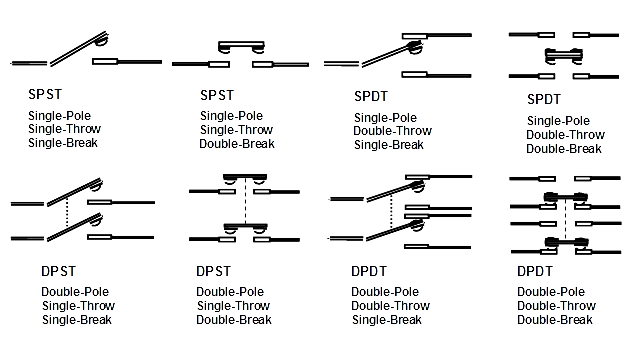Electrical switches can adapt to misunderstandings in the application / application to ensure no leakage current and make them available in multiple circuits, actuators, and housing styles. Disadvantages include their number, limited communication life cycle, large size and slow response.
Solid Switch
Solid switches electric appliances that do not have aging moving parts. They are able to switch quickly without any spark between contacts or problems with communication rust. Their disadvantages include high construction costs at current very high rates.
When selecting a level switch, the user needs to determine if the power circuit needs a switch that is usually open or closed.
Normally Open (NO)
The switches do not currently allow for free access. They need to “create” a contact in order to activate it.
Normally Closed (NC)
The switches currently allow free access and require a “break” contact (open) to be activated.
Stick / Throw
Most switches have one or two poles and one or two throws, but some manufacturers will produce custom-level switches for specialized apps. The number of poles indicates the number of different circuits that can be switched on at the same time.

The cast number describes the number of circuits each pole can control. This is indicated by a circuit configuration (NO / NC). Pause is a circuit breaker caused by contacts that are separated by a switch that introduces each circuit that opens or interrupts the circuit.
Electrical Changing System and Types
Single Pole, One Throw (SPST)
Single pole, single throw switches (SPST) make or break a single conductor connection in a single branch circuit. They usually have two terminals and are called single-pole switches
Single pole, Double Throw (SPDT)
A single pole, dual switches (SPDT) makes or breaks a single conductor connection with one of two conductors. They usually have three terminals and are usually used in pairs. SPDT switches are sometimes called three-way switches.
Double Pole, Single Throw (DPST)
Double pole, single throw switches (DPST) make or break the connection of two circuit conductors in a single branch circuit. They usually have six terminals and are available in both temporary and maintenance communication versions.
Double Pole, Double Throw (DPDT)
Double pole switches, double throw (DPDT) make or break the connection of two conductors in two different circuits. They usually have six terminals and are available in both temporary and maintenance communication versions.
![]()
Electrical switch contacts are either normally-open or normally-closed, depending upon the open or closed status of the contacts under “normal” conditions.
But what exactly defines “normal” for a switch? The answer is not complicated, but it is often misunderstood because of the ambiguous nature of the common word.
The “normal” state of the switch is the state of electrical contacts in the state of non-physical regeneration. One way to think of a “normal” situation is to think of a change in relaxation.
With the change of the temporary contact button, this may be the status of the switch contact if it is not pressed. Electric switches are always designed with scheme drawings in their “normal” conditions, regardless of the type of operation.
The “normal” state of the switch (closed) is actually an abnormal state of the internal process (low flow), for the simple reason that the switch should be stimulated and not rested while the process is running. as it should.
Below listing of “normal” definitions for various process switch types:
- Limit switch: target not contacting the switch
- Proximity switch: target far away
- Pressure switch: low pressure (or even a vacuum)
- Level switch: low level (empty)
- Temperature switch: low temperature (cold)
- Flow switch: low flow rate (fluid stopped)
Symbols of electrical switches








![]()